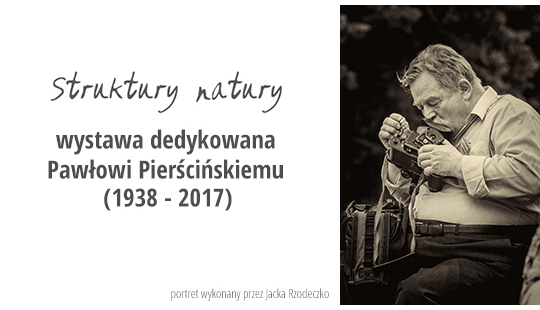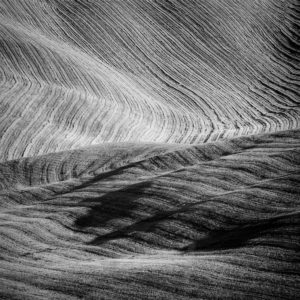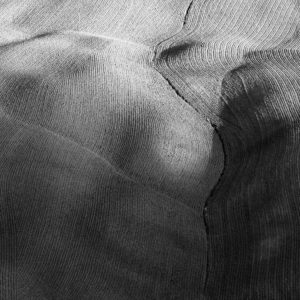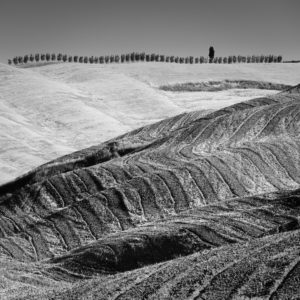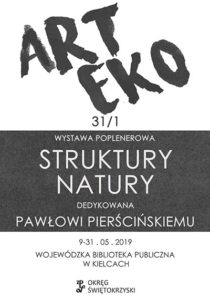 Exhibition dedicated to Paweł Pierściński, invites the Świętokrzyski District of the ZPAF
Exhibition dedicated to Paweł Pierściński, invites the Świętokrzyski District of the ZPAF
Voivodeship Public Library in Kielce, 13 ks. Piotra Ściegiennego St.
Vernissage on Thursday 9 May at: 18:00, exhibition until 31 May 2019
Commissioner of the open-air workshop, exhibition curator: Andrzej Borys
ART-EKO 31/1 – is a project that is a continuation of the thirty previous ART-EKO plein-airs.
Over the course of three decades, the participants of ART-EKO plein-airs have recorded the borderlands of Poland, the Roztocze and the Świętokrzyskie region in their photographic work. Each open-air workshop has had almost thirty participants, which over 30 years has resulted in a very sizeable group of photographers and visual artists.
The ART-EKO project has become recognised throughout Poland and abroad. Our plein-air events have hosted photographers from 10 countries. The result of the photographic realisations were post-exhibitions with documentation in the form of printed or digital catalogues.
The history of ART-EKO plein-air events was sometimes difficult and turbulent, but we always managed to continue our plein-air events. It survived the times of martial law and economic crisis. The most dramatic was the 30th anniversary ART-EKO plein-air. It simply was, that much can be said about it. It is better to lower the curtain as soon as possible and forget it.
In 2018, the Initiative Group of the Świętokrzyskie District of the ZPAF, consisting of: Zofia Turno, Wiesław Turno, Waldemar Kozub, Piotr Wypych and Andrzej Borys, decided to continue the ART-EKO project, giving it a thematic rhythm consistent with the activities of the Kielce Landscape School: ART-EKO 31/1 “Structures of Nature” with a dedication to Paweł Pierściński, our union colleague and founder of the Świętokrzyskie District of the Union of Polish Artists Photographers.
The results of the work of the invited photographers can be seen at the post-exhibition and in the exhibition catalogue. As the project’s commissioner, I would like to express my sincere thanks to all the participants who took part in the 30-year-long ART-EKO project, especially to my colleagues who organised the plein-air workshops: Jerzy Piątek, Andrzej Pęczalski (curators of the first two workshops), Jarosław Korbiński, Antoni Myśliwc, Andrzej Łada and Wiesław Turno (who repeatedly conducted the ART-EKO workshops). I hope that ART-EKO will continue for the next decade, and maybe even longer.
Andrzej Borys – organiser and commissioner of 18 ART-EKO open-air workshops
Participants of the All-Poland Photo Plein Air ART EKO 31/1 – Chęciny 2018,
which took place from 4 – 7 October 2018.

A total of 36 authors presenting 110 photographic works:
Robert Andre – Koło, Przemysław Barański – Radom, Robert Baś – Kraków, Piotr Bieniek – Kraków, Andrzej Borys – Kielce, Artur Dziwirek – Kielce, Alek Figura – Wrocław, Tomasz Grzyb – Radom, Marcin Jastrzębski – Lublin, Ryszard Karczmarski – Chełm, Sebastian Klochowicz – Radom, Jarosław Korbiński – Kielce, Waldemar Kozub – Kielce, Katarzyna Łata – Katowice, Cezary Łutowicz – Sandomierz, Andrzej Mochoń – Kielce, Sławomir Oszywa – Kielce, Zbigniew Podsiadło – Sosnowiec, Jolanta Rycerska – Warszawa, Jacek Rzodeczko – Kielce, Waldemar Siatka – Zamość, Jarosław Siłakiewicz – Kielce, Zdzisław Słomski – Radom, Piotr Spek – Piła, Małgorzata Stępnik – Kielce, Brunon Szczapiński – Warszawa, Wiesław Turno – Końskie, Zofia Turno – Końskie, Magdalena Wdowicz-Wierzbowska – Warszawa, Paweł Wójcik – Kielce, Mieczysław Wroński – Stalowa Wola, Piotr Wypych – Piotrków Trybunalski, Sławomir Zieliński – Kielce, Waldemar Zieliński – Jelenia Góra, Jan Zych – Kraków, Andrzej Zygmuntowicz – Warszawa

Click to view/download the extensive exhibition catalogue
in it, texts by Andrzej Borys, Waldemar Kozub, Cezary Łutowicz and more works by the authors participating in the exhibition – published in print thanks to the support of the Fund for the Promotion of Creativity of the Association of Authors ZAiKS.
Structures of Nature, dedicated to Paweł Pierściński
The initiative of the Świętokrzyskie Region of the ZPAF under the title Art Eko is an open-air workshop which is a meeting of various photographic personalities, with presentations of works, discussions and, above all, an exploration of the place where the workshop takes place and recording the impressions arising there in photographs. The plein-air itself is a platform for exchanging views and attitudes and a presentation of the various ways of using photography as a communication system. The result of the plein-air workshop is an exhibition and a catalogue of the exhibition is a permanent trace. This is an important part of the whole Art Eko initiative. Impressions from the plein-air workshop remain in the minds of the participants, the exhibition, even after the longest exposition, disappears from the walls of the gallery, what remains is a publication that gives an idea of the exhibition and what the authors were interested in, even years later.
The last 31st Art Eko meeting took place at the beginning of October 2018. It was initiated by Andrzej Borys with the support of a group of Świętokrzyskie photographers, the organiser of many open-air events in this series over the years. 34 photographers came from all over Poland. The theme was “Structures of Nature”, but the important subtitle was “with dedication to Paweł Pierściński”. The reference to this outstanding artist was obliging. With his works and theoretical considerations, Pierściński drew attention to landscape as a special record of agricultural culture, creating plastic signs in the Polish landscape. He was interested in the peculiar marking of space by the actions of people attached to the land. In his frames, he combined the relationship between how man shapes the space subjected to him and how nature itself orders in its own way the terrain over which it rules. Paweł Pierściński’s vision of space inspired many other photographers from the Świętokrzyskie milieu, which led to the birth of the Kielce School of Landscape and, with it, the creation of one of the most interesting ways of talking about the special space that is the Świętokrzyskie region and northern Małopolska. The last Art Eco took place in Chęciny, surrounded by hilly terrain, fields, forests, roads, including a motorway under construction, buildings, some inhabited and some long abandoned. Apparently the same places that fascinated Pierściński. However, years have passed since he travelled through these areas. Poland is already a different country and a different. Seemingly the same places that fascinated Pierściński. However, years have passed since he travelled through these areas. Poland is already a different country and our native landscape looks different. Small plots of land are no longer visible, it is not profitable to cultivate them. Today, something else grows in the old fields, which used to form fascinating chequered arrangements, overgrown with cereals, vegetables or plants for fodder. Those plastic games, filling the hills of the Świętokrzyskie region, have disappeared and with them the basic theme of the Kielce School of Landscape. By the way, how many years can the same theme be pursued?
Photographers attempting to record the landscape in their frames today face completely different challenges from those faced by photographers a generation or two ago. The natural spaces have undergone new transformations, resulting from economic development and its consequences in the form of the decline of pegeer and agricultural cooperatives, in the form of wide roads cutting through mountains and valleys, in the form of large-scale farms, the abandonment of small fields and the wilding of vegetation therein. The time of the Kielce School of Landscape, now closed, was perfectly in line with the idea shown in the exhibition “The Land: Twentieth century landscape photographs” organised by Bill Brandt in 1975. It is worth mentioning that this exhibition included Paweł Pierściński and Wiesław Prażuch among the world giants. The exhibition was an admiration for the beauty, but also for the power of nature and the magic it can produce, as well as a remark on the role of man, who, with his actions, contributes to the creation of a plastic order supporting the work of nature.
And today, it is possible to find similar themes in the landscape around us, but perhaps more true today is the view proposed by the authors of the American exhibition New Topographics: Photographs of a Man-Altered Landscape, prepared by William Jenkins for the International Museum of Photography, George Eastman House in Rochester and also exhibited in 1975. The authors abandoned previous ways of telling the landscape story. This was largely due to the changes in the American countryside and the dominance of suburban and urban spaces, not so much in the landscape as in the everyday lives of Americans moving from the countryside and farms to more densely populated areas. The new topographers were interested in changing what was the real point of reference for the inhabitants of their country. The beauty of the landscape remained in the protected national parks, while outside them, new things emerged: industry, intrusive advertising, the cheap architecture of roadside motels and suburban estates.
The same processes that are changing the landscape have reached Poland. The meeting of photographers in Chęciny was an attempt to discuss how to talk about the contemporary appearance of the space that surrounds us. The subtitle of the post-opening exhibition narrowed the focus a little, as Paweł Pierściński has become famous for landscapes filled with order, orderly composition and the energy of light. In view of this, is it appropriate to tell a much different story than he did?
The post-interval exhibition does not provide a clear answer. The evening meetings of the participants in the plein-air workshop were more devoted to the presentation of their works (praise to the authors who brought their own) and to bringing closer their own thinking about photography than to seeking some kind of collective, coherent view of the contemporary landscape of a country that has joined the global economic system and is doing quite well in it. Such a discussion would be useful for the entire community, perhaps we could remain faithful to Paweł Pierściński’s proposals, or perhaps we could modernise his vision a little? The symposia accompanying the Kielce Landscape Biennale used to be an intellectual support for landscape photographers.
Art Eko can easily be a comparable platform for discussing the Polish landscape, what it really is and therefore how to show it. The diversity of attitudes of the authors of the post-interval exhibition shows their individual potential, from referring to the Kielce School of Landscape, through threads inspired by elementary photography, to wandering along paths indicated by new topographers, present not only in American photography. The Art Eko exhibition presents the author’s changing visions, from documentary thinking, free impressions resulting from fascination with the landscape, focus on unobtrusive but intriguing details, to admiration for the dignity and beauty of pure landscape. The author’s proposals vary, often markedly, just as the space surrounding each of us varies. No common position or conscious discussion of differing attitudes was negotiated, during the nightly outdoor disputes, to be presented to the viewers. As a result, the exhibition is a collection of individual visions rather than a generalised view or a dispute between two somewhat oppositional interpretations of landscape. In spite of this, it remains an interesting proposition for landscape photographers seeking their own paths, although all feel the spiritual presence of the great master.
Andrzej Zygmuntowicz
My photographs presented in the exhibition:
